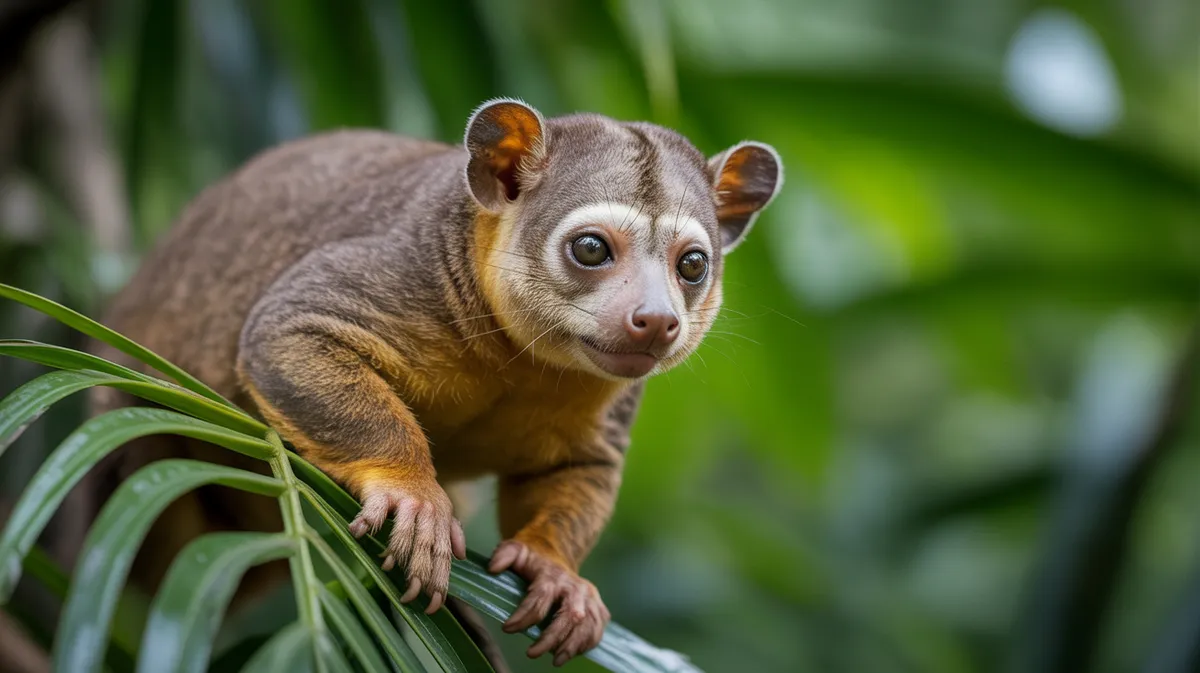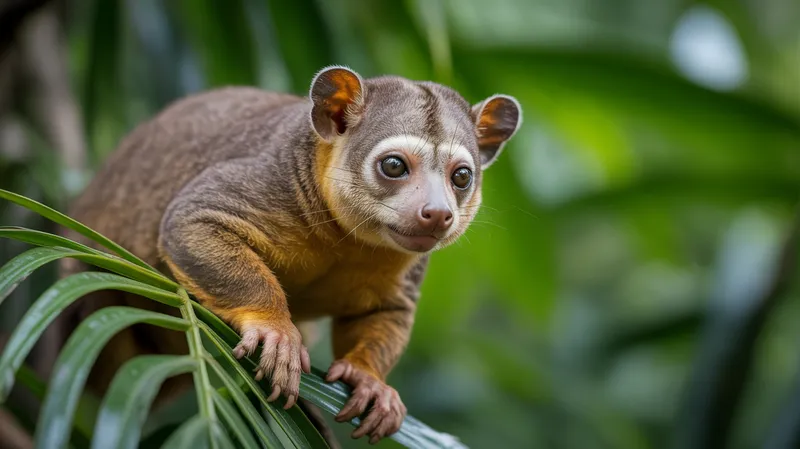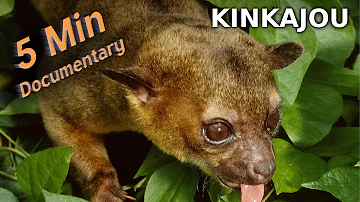
Kinkajou
Potos flavus

Meet the Kinkajou
The kinkajou, also known as the 'honey bear,' is a nocturnal mammal native to the tropical forests of Central and South America. It has a slender body, a prehensile tail, and soft golden-brown fur, making it well adapted for an arboreal lifestyle. Despite its bear-like nickname, the kinkajou is more closely related to raccoons and olingos. Kinkajous are highly agile climbers, using their tail almost like a fifth limb to grasp branches and hang upside down while feeding.
Classification
Mammal
Habitat
Tropical rainforest
Diet
Omnivore
Lifespan
20-25 years in captivity
Conservation
Least Concern
Weight
1.4–4.6 kg
📖Fascinating Facts
Nocturnal Lifestyle
Kinkajous are active primarily at night, using their keen senses of smell and touch to navigate the treetops in total darkness.
Prehensile Tail
Their strong, grasping tail acts as an extra limb, helping them balance, climb, and even hang while feeding.
Honey-Lover
Kinkajous are fond of honey and nectar, using their long tongues to reach into beehives and flowers for sweet treats.
📋Detailed Description
The kinkajou (Potos flavus) is a small, arboreal mammal of the family Procyonidae, distinguished by its long, prehensile tail, which can be as long as or longer than its head and body combined (tail length: 39–57 cm; body length: 40–60 cm). Adults typically weigh between 1.4 and 4.6 kg. Its dense, woolly fur is golden to brownish, providing camouflage in the rainforest canopy. The kinkajou has a rounded head, large forward-facing eyes adapted for nocturnal vision, and a short, pointed snout. Its tongue is exceptionally long (up to 13 cm), allowing it to extract nectar and honey from deep within flowers and beehives. Kinkajous possess five-toed feet with sharp, curved claws and flexible joints, enabling them to rotate their hind feet backwards for agile climbing and descending trees headfirst. They are primarily solitary but may form loose social groups, especially when foraging. Their vocalizations include barks, screams, and high-pitched whistles. Kinkajous are known for their longevity, living up to 23 years in captivity and likely over 20 years in the wild. Their diet is omnivorous but heavily frugivorous, with fruit comprising about 90% of intake, supplemented by nectar, honey, flowers, and occasionally small vertebrates and insects.
💡 Did you know?
Kinkajous can rotate their feet backwards, allowing them to run easily in either direction along branches and climb down trees head-first.
🔬Research & Sources
Wikipedia Summary
The kinkajou is a tropical rainforest mammal of the family Procyonidae related to olingos, coatis, raccoons, and the ringtail and cacomistle. It is the only member of the genus Potos and is also known as the "honey bear". Though kinkajous are arboreal, they are not closely related to any other tree-dwelling mammal group.
Last Modified: 6/11/2025
🎭Behavior & Social Structure
Kinkajous are strictly nocturnal, emerging at dusk to forage and returning to their tree hollows or dense foliage to rest during the day. They are highly arboreal, rarely descending to the ground, and use their prehensile tail for balance, support, and even as a fifth limb while feeding. Their foraging behavior is characterized by slow, deliberate movements through the canopy, often traveling several kilometers each night in search of fruiting trees. Kinkajous are known to be opportunistic feeders, sometimes raiding beehives for honey or consuming eggs and small animals. Social interactions are generally limited to mothers with offspring or brief encounters at abundant food sources, where mutual grooming and play may occur. Scent marking with secretions from abdominal glands and urine is used for territorial communication. Vocalizations serve to maintain contact and warn off intruders.
👶Reproduction & Life Cycle
Kinkajous are polyestrous, with breeding possible year-round, though peaks may occur in some regions during the wet season when fruit is most abundant. Courtship involves vocalizations and mutual grooming. After mating, females undergo a gestation period of approximately 112–118 days. Typically, a single offspring is born (rarely twins), weighing about 150–200 grams. Neonates are altricial, with eyes and ears closed at birth, and are cared for exclusively by the mother. Young kinkajous open their eyes at around 10 days and begin to climb at 8 weeks, but remain dependent on maternal care for up to 3 months. Sexual maturity is reached at 18–24 months.
🛡️Adaptations & Survival
Kinkajous exhibit several remarkable adaptations for arboreal and nocturnal life. Their prehensile tail provides stability and allows them to hang while feeding. Highly flexible ankles enable hind feet to rotate 180 degrees, facilitating headfirst descent. Their large, sensitive eyes enhance night vision, while acute hearing aids in detecting predators and prey. The long, slender tongue is specialized for extracting nectar and honey, making the kinkajou an important pollinator for certain rainforest plants. Their dense fur protects against rain and insect bites. Scent glands on the abdomen are used for marking territory and social signaling.
🎨Cultural Significance
Kinkajous are known as 'micoleón' or 'lion monkey' in Spanish-speaking regions, and 'honey bear' in English, reflecting their fondness for honey and bear-like appearance. In indigenous folklore, they are sometimes associated with mischief or trickster spirits due to their elusive, nocturnal habits. In some areas, kinkajous have been kept as exotic pets, though their nocturnal and arboreal nature makes them challenging to care for in captivity. There are no widespread traditional medicinal or ritual uses documented.
🔬Recent Research & Discoveries
Recent studies have focused on the kinkajou's role as a pollinator and seed disperser, highlighting its ecological importance in maintaining rainforest biodiversity. Genetic research has revealed significant variation among subspecies, suggesting historical isolation and adaptation to local environments. Ongoing research is investigating the impact of habitat fragmentation on movement patterns and genetic diversity. Advances in camera trapping and radio telemetry have improved understanding of their home range sizes and nocturnal activity patterns. Disease transmission between kinkajous and humans, particularly in the context of the exotic pet trade, is an emerging area of concern.
🎥Wildlife Videos

Kinkajou - 5 Minute Documentary
Embark on a vibrant five-minute journey into the lush realms of the rainforest with a delightful documentary uncovering the life of ...
Five Minute Documentaries

The Cloud Forest - Before It Is All Gone | A nature documentary (kinkajou, toucan, quetzal, birding)
In this episode of Before It Is All Gone free documentary series filmed in 4K, we visit the different cloud forests of Ecuador.
Before It Is All Gone

Wildlife - The Fascinating World of Wild Animals | Full Series | Free Documentary Nature
Wildlife - The Fascinating World of Wild Animals | Wildlife Documentary Watch 'Ocean Stories - Full Series' here: ...
Free Documentary - Nature

Raja the Rowdy Kinkajou | Dr. K's Exotic Animal ER
#NatGeoWILD #Kinkajous #DrK About Dr. K's Exotic Animal ER: Dr. Susan Kelleher owns and operates one of the busiest exotic ...
Nat Geo Animals

Dead by Dawn: The World of Killer Creatures MEGA EPISODE | S1 COMPILATION | Nat Geo Wild
Dead By Dawn 101-105 "Night of the Living Dead" The jungles of Indonesia are a world of beauty and mystery. As night ...
Nat Geo Animals

Discovering the Kinkajou: The Rainforest's Hidden Gem
Discover the enchanting world of the kinkajou, a unique yet often overlooked rainforest resident! In this video, we delve into the ...
Earth’s Wonders Unveiled
🌍Habitat Information
The Kinkajou typically inhabits Tropical rainforest environments. Kinkajous have adapted to their environments with specialized features and behaviors.
Primary Habitat:
Tropical rainforest
More detailed habitat information will be available soon.
🛡️Conservation Status
The Kinkajou is currently classified as Least Concern. Conservation efforts are crucial for preserving this species for future generations.
Common Threats:
- 🏠Habitat loss and fragmentation
- 🌡️Climate change impacts
- 🎯Hunting and poaching
- 🏭Human-wildlife conflict
⚠️Threats & Conservation Challenges
While currently listed as Least Concern by the IUCN, kinkajou populations face localized threats from habitat loss due to deforestation, fragmentation, and agricultural expansion. They are also hunted for the pet trade and for their fur and meat in some regions. Road mortality and persecution as crop raiders further impact populations. Although adaptable, their dependence on mature forests and fruiting trees makes them vulnerable to ongoing habitat degradation. Population trends are stable in many areas, but declines have been noted where forest cover is rapidly diminishing.
🔬Scientific Classification
Scientific Name
Potos flavus
Classification Hierarchy
🔍 About Taxonomic Classification
Taxonomic classification is a hierarchical system used by scientists to classify and organize living organisms based on shared characteristics and evolutionary relationships.
The system moves from broad categories (Kingdom) to increasingly specific ones, with each animal's scientific name typically consisting of its Genus and species.
📝Community Notes
Share your observations and insights about the Kinkajou with our community of wildlife enthusiasts.
Join Our Community
Sign in to share your observations and connect with fellow wildlife enthusiasts.
Sign In to ContributeNo community notes yet
Be the first to share your observations about the Kinkajou!
Explore Kinkajou
Select a tab above to learn more about this amazing animal.
📸Photo Gallery
No photos available for this animal yet.
🌟Discover More Wildlife
Continue your journey of discovery with more fascinating animals from our database
